Backlink Types for SEO
Join the 1,000+ brands that trust us for their link building.
Backlinks are one of the most important (if not the most important) factors in how sites get ranked on the search engine results pages.
Every high-ranking web page typically has an assortment of high-quality incoming links, and there is a substantial correlation between the number of good links a site has pointing to it and its exposure in search engines.
Because there are many different types of backlinks, a good way to boost your page’s rank is to focus on getting a variety of quality backlinks (known as link diversification). Having said that, not all backlinks are created equal, and building an optimal backlink profile will take a concerted effort at executing a sound link building strategy.
To gain backlinks in order to diversify your link profile, it’s important to learn as much as you can about the different types of backlinks, how they can benefit your target sites, and how many you should acquire. This is all-important knowledge for any SEO who takes their craft seriously.
To help you get started, we’ve put together this exhaustive list of the types of backlinks you can acquire to help boost your search engine rankings. We’ll start by describing some generic categories of backlinks (e.g. NoFollow, DoFollow, Pillow, Authority, Contextual), before diving into the specific backlink types within each category which you can implement into your link building strategies.
NoFollow Links
In the 1990s to early 2000s people realized that it was easy to create a bunch of backlinks by spamming comments with links on other websites such as blogs. To curb the gaming of search engines with this tactic, web developers created the nofollow hyperlink attribute.

This nofollow tag can be added to the HTML code of a hyperlink to indicate that the destination of the URL shouldn’t be given any additional weight or ranking by search engine algorithms.
Search Engines like Google claim that nofollow links are ignored by algorithms such as Google’s Page Rank, but no one knows for sure.
Nofollow links won’t be worth as much to you as dofollow links, but all of our data shows that sites ranking well in the SERPs have a healthy balance between nofollow/dofollow links (making them an essential component of appearing natural). Therefore, we don’t really check how many nofollow backlinks we receive (because we don’t really care about them).
DoFollow Links
Dofollow is the default characteristic of most types of backlinks. A hyperlink doesn’t need any specific code added for it to be dofollow.
Dofollow links count towards search engine ranking and are thus preferable for link building efforts under most circumstances. But as previously stated, it’s considered natural for a site to have a healthy amount of both dofollow and nofollow links (in relation to other similar/relevant websites).
Pillow Links
Pillow links are types of backlinks that add diversity and naturalness to your profile. They don’t really provide raw ranking power unless your site is in a very low-competition niche. Instead, they provide insulation for your other link building efforts.
These natural links should be used in the beginning and throughout the ranking process to help establish your website (i.e. indexation) and provide a buffer. There are many types of backlinks that fall under the “pillow link” category including citations, social profiles, forum posts, press releases, niche directories, and blog comments.
The various types of pillow links are usually free or easy to create for anyone who has the willpower and know-how. They are essential to building and developing a site because they create “buzz” about your website/business, and help build relevance and diversity while signaling to Google that your website is legitimate and functional.
Authority Links
These are the types of backlinks that provide the raw ranking power, authority, and relevance to help boost your website’s ranking in a SERP.
Authority links, in contrast to pillow links, are almost always dofollow. Examples of this type of powerful, high-quality backlinks include guest posts, PBNs, niche edits, and editorial links. These types of backlinks will be explained in greater detail.
Note: We use the term “authority” to describe powerful ranking tools (i.e. quality backlinks) that we use and provide through our link building services. It should not be confused with “domain/page authority”, which is a widely used term to describe the quality of websites/pages.
Contextual Links
A contextual link is a link that appears within a paragraph of text rather than on a menu, sidebar, widget, etc. Contextual links have the added benefit of drawing relevance from the information that surrounds them.
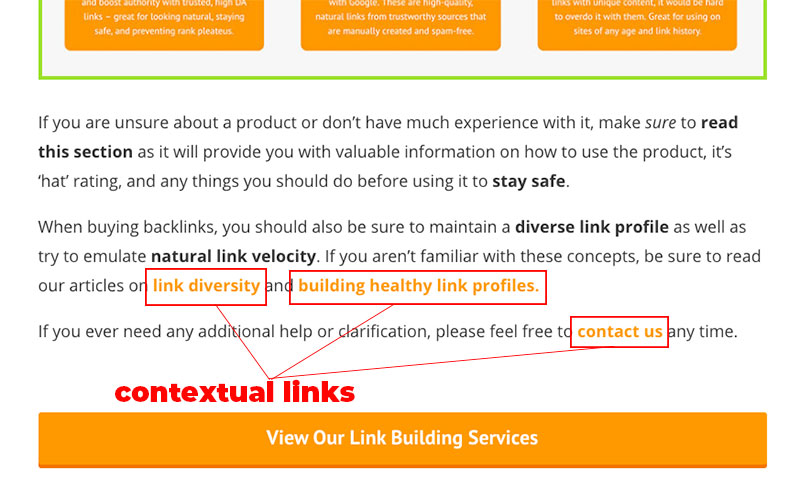
When pursuing authority links, people will generally prefer contextual links over non-contextual links. A curated link is a prime example of a contextual, authority backlink.
Guest Posts
Guest posts are one of our favorite types of authority links. They are respected and used widely within the SEO community. A guest post is an agreement between a webmaster and an author in which the guest post author publishes an article on the webmaster’s blog – usually in exchange for getting a link placed contextually within the blog post that points to the author’s target site.
Guest posts can be either paid links from vendors or free (through manual outreach).
Guest posting can produce a high-quality backlink, which may greatly benefit your rankings if it’s acquired from a quality linking site (i.e. trusted, relevant, and authoritative) and surrounded by high-quality content.
Guest blogging backlinks tend to be contextual and topically relevant (high-quality attributes in terms of ranking potential). Guest post bio backlinks (aka author bio links) are a variation of guest blogging backlinks in that the outbound link is inserted in the guest author’s bio section.
If you’ve decided to find guest blogging opportunities via manual outreach (contacting editors and other website owners directly), then you’ll want to make sure and deliver high-quality content that lives up to the level of value that you promised the other party in exchange for a backlink.
Having said that, we think it’s a lot easier to simply buy guest post links from a company that provides a guest blogging backlinks service.
(Read more about finding guest post opportunities and guest blogging best practices to really step up your game).
PBNs
PBN links are contextual, authority backlinks typically located on the homepage of a blog owned for the sole purpose of manipulating search engines. These blogs are repurposed domains intended to pass as much power and link juice as possible to their targets (and they are part of a group of sites called a private blog network).
The idea is to take aged domains with a rich backlink history and rebuilt them from the inside out to provide money sites (i.e. target sites) with authority homepage links that will help them rank exponentially.
Having said that, this advanced link building strategy is seen as manipulative (and unnatural) from a search engine’s view (i.e. Google) because the blogs are deployed only to pass power to a money site instead of providing useful information to visitors. In fact, many PBN linking sites rarely get visitors because they don’t rank in the SERPs (that’s not their intended purpose).
When used carefully, PBNs are valuable links for delivering a lot of power to their respective targets. But proceed with caution when using this extremely potent ranking tool to avoid any Google penalties or the dreaded deindexation of the entire PBN network.
If you are new to PBN link building, resources like our PBN checklist should be read and understood before proceeding to use these types of backlinks.
Niche Edits
Definitely one of our favorite types of backlinks is the versatile Niche edit (or curated link). These powerful ranking tools are contextual links that are inserted into relevant, existing articles which are already resonating in the Google SERPs (such as blog posts covering your target niche).
Niche edits are authority links that are quite similar to high-quality blog posts, with a few exceptions:
- The articles are aged instead of new.
- The articles may have an existing backlink profile (guest post articles do not).
- You only have control over your URL (and its anchor text) rather than its contextual content (you might also be able to choose the linking site’s niche).
- They are generally cheaper than guest posts.
Being slightly different than guest posts due to their age and existing link profiles, curated links make a great tool to work in alongside your other links in building diversity and adding authority, relevance, and power to the target site. A cheap barrage of niche edits is particularly effective at reviving a site that’s been damaged by a penalty or quickly building relevance to a target niche.
Editorial Links
The editorial link is the last type of authority link on our list. It’s essentially like a guest post, but much harder to obtain, because the linking site is intended to be highly authoritative and exclusive (so they are picky about their content providers). This means an editorial backlink may be too expensive for your link building budget.
Editorial backlinks are outbound links associated with news publishing sites such as Forbes and USAToday. More generally speaking, an editorial link comes from a trustworthy source with very high domain authority (i.e. it has tons of high-quality content and referring domains).
Imagine a staff writer at the New York Times needing to cite some references in an article by linking out to other websites. That editorial link is delivering a boatload of power to whichever web page that’s fortunate enough to be on the receiving end.
Literally speaking, “editorial” simply means any article that is prepared or commissioned for publication. So editorial backlinks are links from other websites which are created by publishing original content. That’s why acquiring an editorial backlink is similar to guest blogging.
(Read more: Buy Editorial Links)
Now let’s discuss the various types of backlinks that we consider to be pillow links. These are highly useful tools for anyone starting a website. Moreover, pillow link building tactic(s) is one of the easiest and cheapest ways to acquire backlinks.
Blog Comments
Posting comments on blogs to build comment backlinks is a good way to diversify your link profile and add some relevance without costing any money. However, don’t expect these comment backlinks to jumpstart your rankings in a hurry or anything like that (which is why we consider them to be pillow links).
To get these links, you just comment on a blog post and leave your website in the details. Your name can be used as the anchor text for your link. It’s that simple.
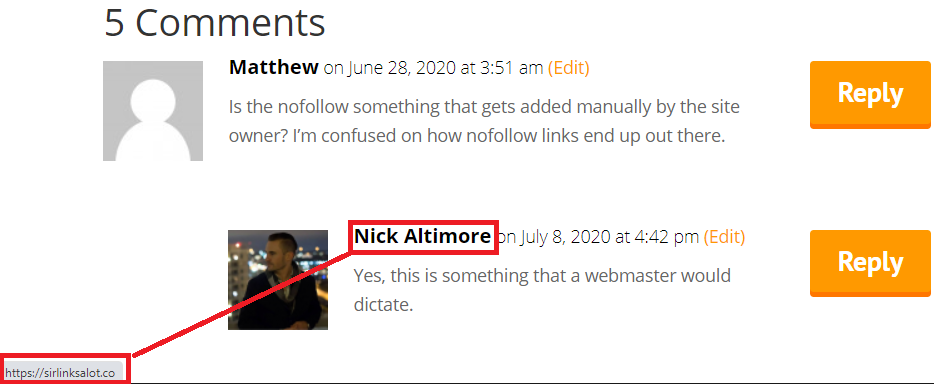
Believe it or not, it was quite easy in the old days to spam blog comments to artificially pump up search rankings. As the Google algorithms evolved to counteract manipulative link building tactics, such as auto-generated content and blog spamming, so did link building strategies for SEO.
But it’s still perfectly natural for a webmaster to leave blog comments with their website URL attached to them.
Done sparingly and naturally, blog comment links are a solid way to diversify your link/anchor profiles, create some buzz, and add relevance.
Social Bookmarks
Social bookmarking sites/platforms are popular content services that allow users to post content and share links to web pages. These social pillow links are simple, free, and natural to obtain.
Because these high authority websites pool web sources that cover lots of shared interests, they are good platforms for you to post genuine comments & your own content about target websites that may interest users. For example, Pinterest is a free tool to post content with background information attached to it.
Also, social bookmarking platforms are a good way to get new web pages indexed (but can be seen as spammy when overused).
Check out our huge list of social bookmarking sites for you to get links on.
Article Directories
Article directory links used to be a big deal back in the day when auto-generated SEO tools weren’t as prevalent as they are today.
The idea was to write an article with a link and submit it to hundreds of article directories in the hope that random publishers will pull it for their content sites.
Eventually, search algorithms began penalizing spammy backlinks associated with low-quality directories and filtering out duplicate content over the web (since low-quality spam articles posted to article directories would proliferate across many locations). Now, article directories no longer have the credibility they once did.
Reciprocal Links (Link Exchanges)
Link exchanges involve two webmasters (or brands) trading backlinks with each other for mutual benefit.
It’s an agreement that seeks to vouch for each other’s content, show an affiliation between two sites, and offer visitors quick access to relevant information.
Reciprocal links are helpful, but shouldn’t be overused, because it’s too easy for a large network of webmasters to collaborate with each other in sharing links.
Pay-per-Click Ads (PPC)
This is an advertising model in which you bid for the right to place an ad with keywords in an auction, such as Google Ads.
When those keywords are entered into a search engine, then the highest bids on those keywords will have their ads displayed more prominently in the search results.

These ads technically have backlinks to your site, however, they should be thought of very differently from other backlinks and do not carry the same weight.
Directory Links
Directory links are deployed in web/industry directories/business listings — online yellow pages or catalogs of sites (often pertaining to a specific niche).
These pillow links are a good way to naturally increase brand awareness in target markets.
Since it’s natural for sites in any niche to be found in niche directories, it makes sense to use directory links in a link building campaign to diversify your backlink profile and add naturalness.
Forum Links
Forums are discussion sites where users post messages about various topics in a hierarchical structure. Pillow links from these online forums and message board sites are called forum links.
There are a few types of forum links depending on where they are placed on the site. For example, a profile page, the signature section of a post, or directly in the main body of the posts throughout the discussion thread.
These links are also very natural to get for businesses, however, like blog comments – you don’t want to spam these out. Google keeps a watchful eye because this link building tactic was also abused in the past.
Author Bio Links
Authors sometimes provide a short bio that accompanies their content piece when posting on a publication that is not their own.
The links they add to their profile are called author bio links.
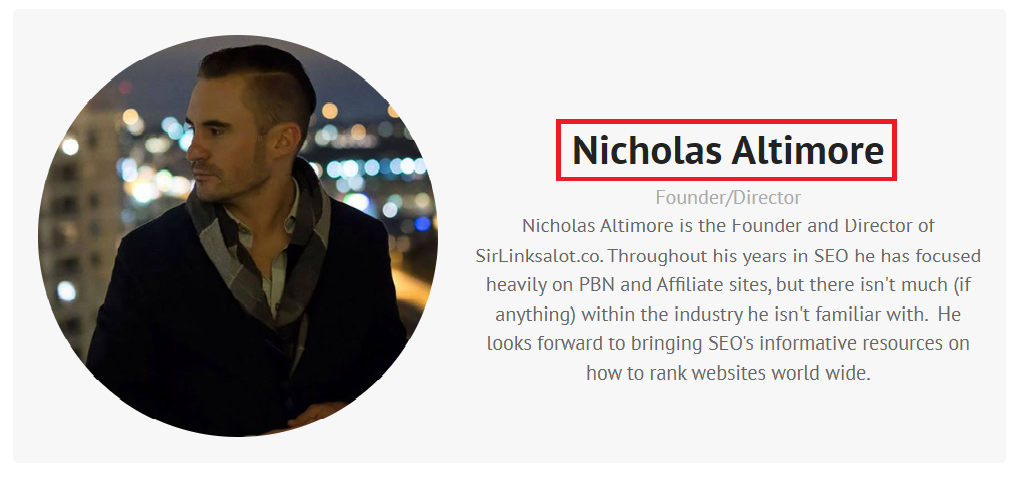
The links can point to more relevant content or to the homepage of the author’s main site or blog, especially if the author is a subject matter expert and wants to provide more information to the reader.
These links are basically guest posts without the benefit of being contextual (and sometimes will be nofollow). You will prefer guest posts links to not be in author bios when possible.
Social Signals
Social signals are social media metrics that signal popularity and affinity towards specific content. Views, shares, comments, likes, and dislikes are examples of social signals on various platforms.
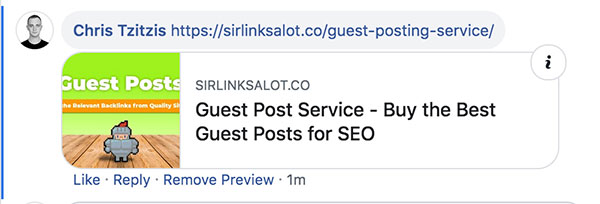
Pillow link building with social signals is about enhancing trust and naturalness since it’s very natural for popular sites to be talked about and linked to from social media sources as well.
Social signals and social media links are not counted in the same way as regular backlinks in terms of their ability to help you rank, but they do have some SEO value.
(Learn more about social signals here).
Auto-Generated Links
Auto-generated backlinks refers to programs that automatically create backlinks for you across various websites (ex: GSA backlinks). Some autogenerated backlinks come from a paid tool.
This is generally thought of as a low-quality link building scheme and a very spammy practice.
We do not recommend using this type of link unless you really know what you’re doing with them (chances are if you are reading this article – you don’t) as they will often end up getting sites penalized to where their Google ranking drops dramatically.
Press Releases
Press releases are official statements issued to news outlets that announce important events and share information on particular matters. These articles will include press release backlinks pointing to your site.
You can build press release backlinks quickly and naturally. And if news sites and other third-party sites notice your press release and share your links, then more power to you!
We recommend only using natural anchors with a press release (i.e. branded, generic, or URL). We also don’t recommend overusing them. These press release links are usually nofollow anyways, so they are considered to be pillow links.
Widget and Sidebar Links
WordPress widgets are dynamic elements, or blocks of content, that you can place in the sidebar or footer of your site that allows you to add extra information. Some examples of widget content include posts, image galleries, Facebook like boxes, and links.
Sidebars are the sections on the side of a blog post that contain sitewide links (if the sidebar appears on each page throughout the website) and additional information.
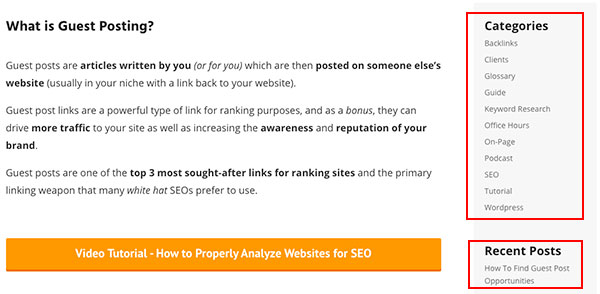
Widget and sidebar links are generally non-contextual, but they still have SEO value if coming from relevant or authoritative sites/articles.
Blogroll Links
A blogroll is a list of posts that a blogger has published, and a blogroll link is a link that appears in the preview text before it is cut off (unless the blog roll is displaying the full post – then it can be anywhere).
Most websites have blogrolls or a list of different articles published on the site. Most of your favorite news sites are examples of blogrolls. PBN sites also make extensive use of blogrolls to host PBN links.
To get a blogroll link, you would need to get a link in a blog post on the site and have the link appear near the beginning of the article so that it appears in the preview text (or just anywhere in the article if the site only displays full posts in the blogroll).
Infographics, Slideshows, Audio, and Video Links
Infographics, slideshows, audio, and video sites all allow you to upload these various types of content to share with others. An example of a video site is Youtube.
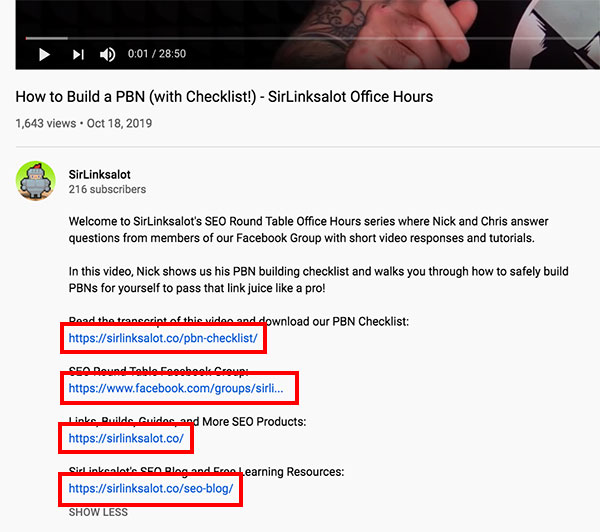
You can get links on these sites by uploading content to the site (i.e uploading a video on YouTube), and then including a link to your site in the content description box.
Very popular pieces of content that can go viral and generate a ton of backlinks for you, but they are still useful even if they don’t. These websites are usually very trustworthy, and links from them make great pillow links.
Footer Links
Footer links are site-wide links placed in the footer section of a web page (the bottom).

These typically appear on each page of a website since the footer section is a sitewide element. This means that getting a footer link on a website could result in thousands of backlinks.
Evidence shows that the law of diminishing returns applies to getting links from domains, so every link past the first will not be worth as much to you.
Footer links are mostly non-contextual.
Redirects
A redirect is a way to send visitors and search engine bots from one URL to another automatically.
The most common type, a 301 redirect, means the web address and its content has moved permanently to another location. 302 redirects are used when content needs to be moved temporarily.
With 301 redirects, you can harness the power of the entire backlink profile of one domain or URL and redirect it to the new target.
When you 301 an entire domain to a new domain, you can think of it as sending all the links from the old domain to the new domain.
Site-Wide Links
Sitewide links are placed on all (or most) of a website’s pages. They can be placed in the header, body, footer, or sidebar of each page.
For example, an ad placed in the footer, or a link in the sidebar of each page on the site, could generate thousands of backlinks to your site if the linking site is large enough.
See the above section out footer links for more information on site-wide links.
Resource Pages
Resource pages are web pages that display helpful resource links about a topic, product, or service.
They are meant to provide many additional resources (websites) for visitors to read when trying to learn about a particular topic.
You can generate backlinks from resource pages by reaching out to webmasters and asking to be included.
Profile Links
The idea for profile links is very simple: create a profile on a website and include a link to one or several of your sites. You can create these profiles on social networking sites (i.e. Facebook, LinkedIn), as well as message forums, Q&A sites, and other platforms.
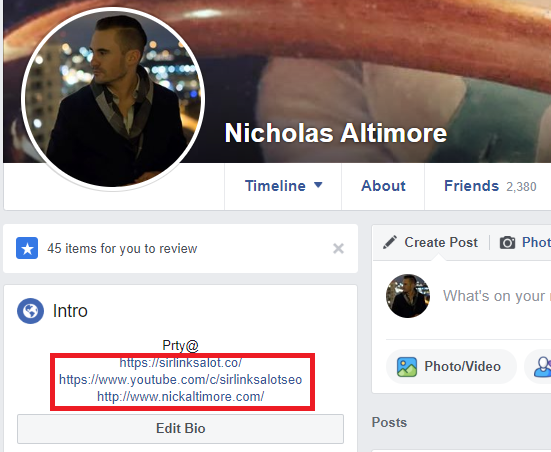
For example, when you join a forum site devoted to restoring classic cars and post a link to your restoration garage on your profile page, then you’re basically creating a profile link. If you establish a profile page for your business on Facebook or LinkedIn, then these are examples of business profile backlinks.
These highly useful pillow links are usually nofollow and non-contextual.
Testimonials and Reviews
Businesses use testimonials and reviews to build trust with customers and learn how to improve products.
Testimonials are highly influential, so you can generate traffic by submitting genuine testimonials and reviews to companies (such as business partners or for products you’ve tried) that contain a backlink to your website.
Review sites, like TripAdvisor, are where you might find a very specific type of pillow link called acknowledgment backlinks.
Image Links
Image links are exactly that – images that link back to your site instead of the usual blue anchor text. You click the image to follow the link to its target.
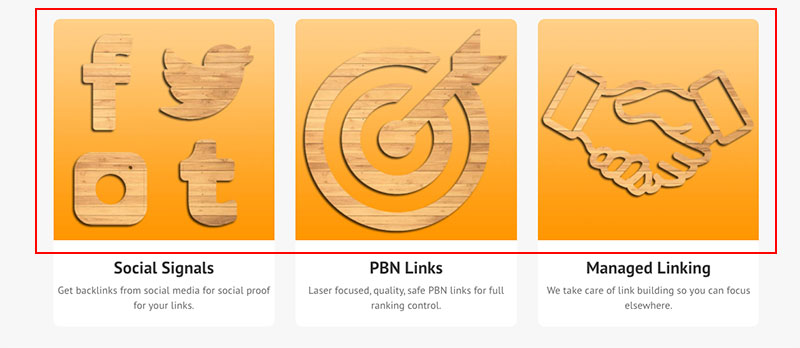
Web 2.0s
Web 2.0s are platforms in which users can create their own mini-web pages (usually for free).
You can then link out to whatever you’d like from your web page on their platform.
To learn more about Web 2.0s, check out our awesome Web 2.0 List or see our free backlinks article.
Citations
Citations allow users to list their name, address, and phone number (NAP) along with a website link to a web directory.
These are basically the same as regular niche directories except that they allow or require you to include your NAP.
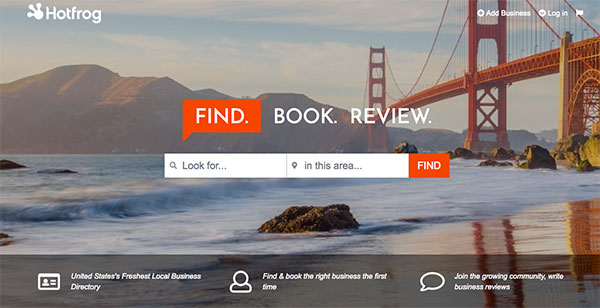
They make great pillow links for your domains because they’re natural, free, and add niche and location relevance depending on the directory listing.
Many SEOs only use citation links for local websites, however, they can be used to pillow affiliate sites just as well.
Backlink Types Wrap-Up
Whew! That was quite the link roundup!
It might be a lot to take in at first, but once you really wrap your head around how all the different backlinks work, then you’ll have a much easier time when you decide to build links. Just remember that each type of link has its own specific uses as well as being able to diversify your backlink profile.
Buying links is much easier than adding them manually. High quality backlinks (which tend to be paid backlinks) include authority links such as guest posts, editorial backlinks, niche edits, and PBNs. Pillow links are used to establish and insulate your website, including social profiles, blog comments, niche directories, citations, press releases, Web 2.0s, blogroll links, and much more. Just avoid free tool backlinks or auto-generated links.
So whether you’re buying backlinks from a white label link building service or choose to acquire links through manual outreach, get out there and get to work!
You can also keep learning about the importance of backlinks from our article on how backlinks help with SEO.
If you have any questions, comments, or which type of paid backlinks are best suited for your needs, please leave a comment below!
 Article by:
Article by:
Nicholas Altimore
Hey I'm Nick, the Founder/Director here at SirLinksalot. I have a passion for building online businesses and taking websites to the next level with the help of my amazing link building team.
 Questions or Comments?
Questions or Comments?
We are active in our Facebook Group seven days a week and would love to hear from you. Ask us questions, learn from other group members, and share your knowledge.
Related Posts
Ready To Start Building Your Rankings?
Your link building journey to the top of Google starts today!
Apply for Managed Link Building to get a free analysis and game plan, or order backlinks a la carte.
Link building services that work.


